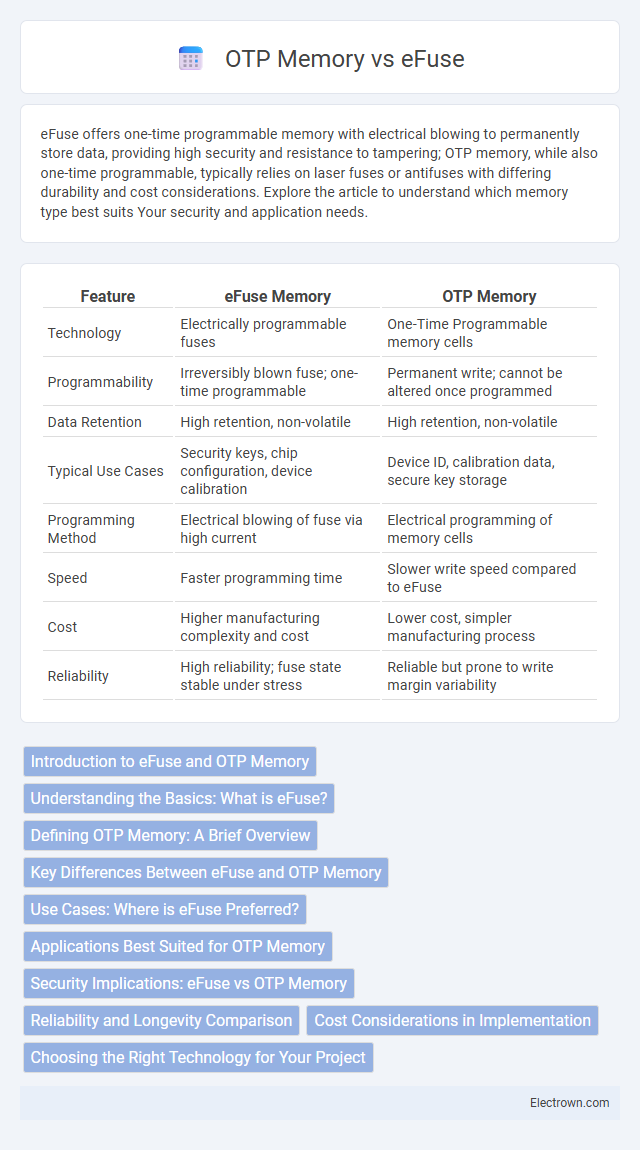eFuse offers one-time programmable memory with electrical blowing to permanently store data, providing high security and resistance to tampering; OTP memory, while also one-time programmable, typically relies on laser fuses or antifuses with differing durability and cost considerations. Explore the article to understand which memory type best suits Your security and application needs.
Table of Comparison
| Feature | eFuse Memory | OTP Memory |
|---|---|---|
| Technology | Electrically programmable fuses | One-Time Programmable memory cells |
| Programmability | Irreversibly blown fuse; one-time programmable | Permanent write; cannot be altered once programmed |
| Data Retention | High retention, non-volatile | High retention, non-volatile |
| Typical Use Cases | Security keys, chip configuration, device calibration | Device ID, calibration data, secure key storage |
| Programming Method | Electrical blowing of fuse via high current | Electrical programming of memory cells |
| Speed | Faster programming time | Slower write speed compared to eFuse |
| Cost | Higher manufacturing complexity and cost | Lower cost, simpler manufacturing process |
| Reliability | High reliability; fuse state stable under stress | Reliable but prone to write margin variability |
Introduction to eFuse and OTP Memory
eFuse and OTP (One-Time Programmable) memory are non-volatile storage technologies used for permanent data storage in semiconductor devices. eFuse consists of electrically programmable fuses that can be selectively blown to store configuration settings or security keys, offering high reliability and tamper resistance. OTP memory stores data by permanently programming bits onto silicon, typically used for device identification, security credentials, or firmware customization.
Understanding the Basics: What is eFuse?
eFuse is a one-time programmable memory technology used for secure data storage and device configuration, providing reliable, irreversible changes at the hardware level. Unlike traditional OTP memory that relies on blowing fuses, eFuse uses electronic signals to permanently alter circuit pathways, enabling precise and tamper-resistant control. Understanding eFuse's operation helps you manage critical information such as encryption keys and device IDs with enhanced security and durability.
Defining OTP Memory: A Brief Overview
OTP memory, or One-Time Programmable memory, is a type of non-volatile memory that allows data to be written once and permanently retained without alteration. It is commonly used for storing firmware, security keys, or device calibration data where permanent code integrity is critical. Your selection between eFuse and OTP memory depends on the specific application needs, such as reconfigurability, security, or data permanence.
Key Differences Between eFuse and OTP Memory
eFuse memory is a one-time programmable technology that relies on electrically blowing fuses to permanently store data, whereas OTP (One-Time Programmable) memory uses a semiconductor process to irreversibly alter memory cells for data retention. eFuse offers higher resistance to physical and electrical tampering, making it ideal for secure key storage and device authentication, while OTP memory provides faster programming speeds and higher density at a lower cost. The main differences lie in their programming mechanisms, security levels, and typical applications in embedded systems and secure microcontrollers.
Use Cases: Where is eFuse Preferred?
eFuse memory is preferred in applications requiring permanent, tamper-proof configuration and security settings, such as device authentication, secure boot, and hardware serialization in smartphones and IoT devices. Its ability to irreversibly program security keys and calibration data makes it ideal for anti-counterfeiting and cryptographic protection. Unlike OTP memory, eFuse offers higher reliability under environmental stress, making it suitable for automotive and industrial electronics where long-term data integrity is critical.
Applications Best Suited for OTP Memory
OTP (One-Time Programmable) memory is best suited for applications requiring permanent data storage, such as firmware storage, device configuration settings, and security keys that must remain unchanged after programming. It is ideal for low-cost, high-volume products where data integrity and protection from alteration are critical, including consumer electronics, smart cards, and embedded systems. OTP memory offers a reliable solution for storing calibration data and unique identifiers in IoT devices and automotive ECUs.
Security Implications: eFuse vs OTP Memory
eFuse memory offers enhanced security by enabling permanent, tamper-resistant configuration or key storage that cannot be altered once programmed, reducing vulnerability to cloning or unauthorized access. OTP (One-Time Programmable) memory, while also providing a one-time write mechanism, may be more susceptible to physical attacks or reverse engineering due to less inherent resistance to tampering compared to the destructive nature of eFuse programming. Both technologies secure sensitive data, but eFuse's physical blow fuse mechanism elevates security against invasive attacks in cryptographic key storage and device authentication applications.
Reliability and Longevity Comparison
eFuse memory offers exceptional reliability due to its non-volatile nature and resistance to radiation disturbances, making it ideal for critical applications requiring long-term data retention. OTP (One-Time Programmable) memory provides permanent data storage with simple programming mechanisms but may exhibit lower endurance and vulnerability to environmental factors over extended periods. The longevity of eFuse surpasses OTP memory since eFuse cells can maintain integrity for decades under harsh conditions, ensuring consistent performance in mission-critical systems.
Cost Considerations in Implementation
eFuse memory offers a lower initial manufacturing cost due to its simpler integration and reduced process complexity compared to OTP memory, which requires specialized fabrication steps. However, OTP memory can incur higher costs in mass production because of its irreversible programming and validation procedures. Evaluating cost considerations involves balancing eFuse's cost-effective scalability against OTP's potentially higher programming expenses and long-term flexibility.
Choosing the Right Technology for Your Project
eFuse memory offers one-time programmability with high reliability and resistance to physical tampering, making it ideal for security-critical applications. OTP memory provides a cost-effective, non-volatile solution suitable for straightforward, one-time programming needs where reprogramming is not required. Assessing factors like security requirements, budget constraints, and data retention needs will help determine the best fit for your project.
eFuse vs OTP Memory Infographic

 electrown.com
electrown.com